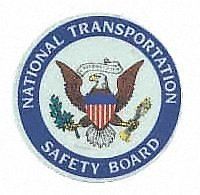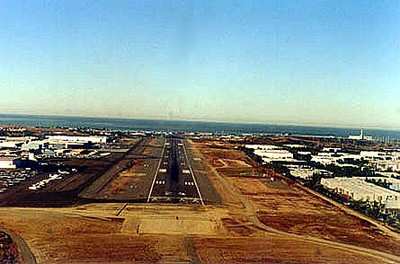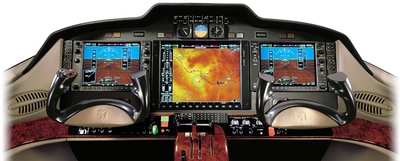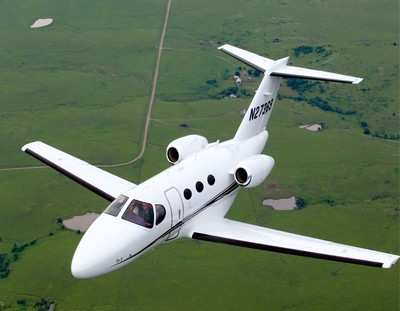Pilot Says PFD, Autopilot Failed En Route, Was 'Fatigued' On
Landing
 Editor's Note:
Sometimes, a runway departure accident isn't just a runway
departure accident.
Editor's Note:
Sometimes, a runway departure accident isn't just a runway
departure accident.
When initial reports first came into ANN regarding a Cessna
Citation Mustang that ran off the side of a runway on landing at
McClellan-Palomar Airport in Carlsbad, CA on April 19, they didn't
seem to indicate anything particularly unusual. After all, it's not
all that uncommon to read about planes exiting the side of a runway
on landing, for any number of reasons... and fortunately, no one
onboard the aircraft was injured.
As you'll read below, however... as it turns out, this was
anything but a "routine" incident...
NTSB Identification: LAX08FA117
14 CFR Part 91: General Aviation
Accident occurred Saturday, April 19, 2008 in Carlsbad, CA
Aircraft: Cessna 510, registration: N54PV
Injuries: 4 Uninjured.
This is preliminary information, subject to change, and may
contain errors. Any errors in this report will be corrected when
the final report has been completed.
On April 19, 2008, about 1010 Pacific daylight time, a Cessna
510 Citation Mustang, N54PV, sustained substantial damage following
the pilot's intentional ground loop maneuver during the landing
roll on runway 24 at McClellan-Palomar Airport, Carlsbad,
California. California Natural Products was operating the airplane
under the provisions of 14 Code of Federal Regulations Part 91. The
commercial pilot and three passengers were not injured. The
personal flight departed from Lincoln Regional Airport, Lincoln,
California, about 0854, with a planned destination of Carlsbad. At
the time of the accident, the pilot had canceled his instrument
flight rules (IFR) flight plan, and was executing a visual flight
rules (VFR) approach to runway 24 in visual meteorological
conditions.

The pilot was interviewed by a National Transportation Safety
Board investigator both immediately after the accident and the
following day with regards to his recollections of events that
transpired. He affirmed that he is the president of the company
operating the airplane. The pilot reported that on the morning of
the accident he flew the accident airplane from Stockton,
California, to Lincoln, which consisted of a 16-minute flight.
After landing in Lincoln he picked up passengers. He subsequently
departed at 0854, and was cleared to 35,000 feet mean seal level
(msl) as requested on his IFR flight plan. The en route cruise was
normal as the airplane approached Carlsbad and the pilot began a
standard terminal arrival route (STAR); during the initial segment
of the STAR the pilot configured the autopilot in vertical speed
mode.
The pilot further stated that as the airplane crossed over the
Avenal transition [waypoint on the SADDE6 STAR] about 30,000 feet
msl, the right [co-pilot's] Primary Flight Display (PFD) began to
flicker. About 5 minutes later, as the airplane continued to
descend through 28,000 feet msl, the left PFD flashed an alert
indicating that the autopilot had disconnected. The pilot
immediately felt the disengagement of the autopilot from what he
described as the heavy control forces on the control yoke that he
had to exert to fly the airplane. He additionally noted that the
autopilot activation light was not illuminated, further confirming
that the system had disengaged. Shortly thereafter, the pilot
discovered that the electric pitch trim [located on the control
yoke] was not operational. After establishing that the pitch trim
was not functional, he ultimately began using the trim wheel
located on the center consol, which operated normally. The pilot
noted that following the autopilot failure, the flight director
bars overlaid about a 10-degree pitch up attitude despite the
descending flight path.

Flying the airplane by hand, the pilot continued the STAR and
reported to air traffic controllers (ATC) that he had an autopilot
malfunction. As the pilot descended to 5,000 feet msl, the airplane
encountered instrument meteorological conditions (IMC). Controllers
vectored the pilot to the instrument landing system (ILS) to runway
24. The airplane broke out of the overcast conditions at 2,600 feet
msl and the pilot relayed to controllers that he would make a
visual approach to the runway. The pilot noted that he was
overwhelmed with the electrical failures and fatigued from
maneuvering the airplane by hand for such a long duration (which he
approximated was around 45 minutes).
The airplane crossed the runway threshold configured with the
wing flaps fully extended [30 degrees] and flying about 15 knots
faster than his predetermined landing speed; the pilot had
previously calculated a Vref speed of 87 knots. From looking at the
airspeed indicator, he noted that the airplane was fast for landing
but thought the runway would be long enough to accommodate the
likely delayed touchdown. As the airplane progressed down the
runway he approached the small uphill slope that was located around
the middle. The airplane approached the apex of the sloping runway
and the pilot began to clearly distinguish where the runway surface
ended, which was sooner than he had anticipated.

The touchdown occurred far down the runway surface, past the
middle location. The pilot realized that despite his braking
attempts and extension of speed brakes, the airplane was going to
continue off the runway surface over a small downsloping cliff at
the end. He determined that he would not be able to abort the
landing due to the airplane's diminished groundspeed and elected to
perform a 180-degree course reversal by rapidly turning the control
yoke. The airplane ground looped, coming to rest in a dirt area
south of the runway; the main landing gear collapsed and the flaps
folded under the wings.
A Federal Aviation Administration (FAA) inspector spoke with a
controller that was in contact with the pilot during the accident
sequence. She observed the airplane approaching runway 24 and noted
that it appeared to be quite high in altitude. In a radio
transmission she queried, "do you think you can make it" to which
the pilot replied "yes." The airplane then touched down on the
runway past taxiway A4 and subsequently ground looped.
Following the accident, the airport issued a special routine
aviation weather report (METAR) at 1012. It stated: winds from 130
degrees at 8 knots; overcast at 2,700 feet; visibility 8 miles;
temperature 14 degrees Celsius; dew point 08 degrees Celsius; and
altimeter 29.95 inHg.
Detailed system examinations are ongoing.
 Aero-News: Quote of the Day (05.13.25)
Aero-News: Quote of the Day (05.13.25) IAG Orders 76 Boeing, Airbus Airliners
IAG Orders 76 Boeing, Airbus Airliners FAA Shuts Down ATC Oversight Review Amid Scrutiny
FAA Shuts Down ATC Oversight Review Amid Scrutiny Montanas ADS-B Privacy Bill Signed Into Law
Montanas ADS-B Privacy Bill Signed Into Law Newark Falls Victim to More Equipment Outages
Newark Falls Victim to More Equipment Outages






